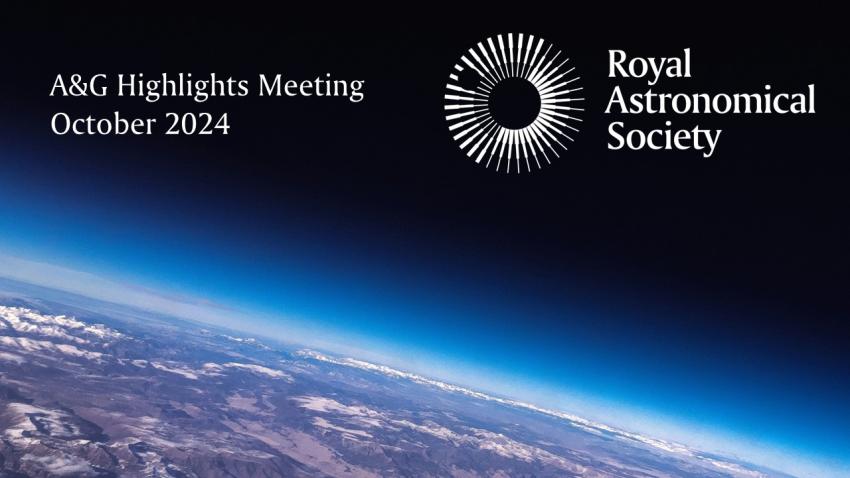Book your FREE RAS A&G Highlights Meeting Ticket
16:00 Prof Mike Lockwood (President)
Welcome and Announcements
16:05 Prof Roberto Orosei (IRA/INAF, Bologna)
Unveiling the interior of the Martian polar caps with radar
Radar sounders with the capability of probing the subsurface of a planetary body from orbit first reached Mars in 2003. Since then, thousands of observations have been recorded by the MARSIS experiment aboard ESA's Mars Express spacecraft, capable of deep penetration, and the SHARAD radar on NASA's Mars Reconnaissance Orbiter, with a tenfold-better vertical resolution. Polar caps are prime targets for radar sounding, as low-temperature ices are very transparent to electromagnetic waves at frequencies from MHz to 100's of MHz. In both caps, dust is mixed with ices in proportions ranging from a few to several percent, unlike terrestrial ice sheets. Dust layers observed in images of scarps and throughs in the Polar Layered Deposits, the main geologic unit constituting the Martian polar caps, can be traced in radar sections for hundreds of kilometers, documenting the history of alternate ice and dust accumulation tied to the climatic history of Mars. Marked differences can be observed in the radar properties of the Northern and Southern caps. It has been proposed that such differences are due to different timing and deposition mechanisms, which has important implications for the understanding of the Martian climate in the last tens of million years and could explain why radar evidence of the presence of liquid water has been found at the base of the Southern polar cap, but not in the North.
Prof Roberto Orosei graduated in Astronomy at the University of Bologna and received a Ph.D. from the University of Rome "La Sapienza". After spending two years as a Research Fellow at the European Space Research and Technology Centre in Noordwijk, the Netherlands, he moved to the Institute for Space Astrophysics in Rome, where he participated in the design and realization of instruments for solar system exploration missions. He is a science team member of space experiments for the Rosetta and Jupiter Icy Moons Explorer missions of the European Space Agency, and for NASA's Cassini, Mars Reconnaissance Orbiter, Dawn and Juno probes. He is the principal investigator of the MARSIS radar on board ESA's Mars Express spacecraft, which provided evidence of the presence of liquid water beneath the South polar cap of Mars. He currently works at the Institute for Radioastronomy in Bologna and teaches a course of astrobiology at the University of Bologna.
16:40 Dr Dmitri Kolotkov (Warwick University)
What makes waves in the Sun’s corona wavy?:
The frozen-in condition and huge values of the magnetic Reynolds number make the plasma in the Sun’s corona essentially elastic, i.e. able to respond periodically or quasi-periodically to an external impulsive perturbation (e.g. flares or small-scale eruptions). It is manifested in observations in the form of directly resolved and ubiquitous waves and oscillations in various coronal plasma structures and indirectly as quasi-periodic pulsations in the lightcurves of solar and stellar flares. Wave phenomena observed in the corona are successfully described by magnetohydrodynamic (MHD) theory. In this talk, specific physical mechanisms which lead to the development of such oscillatory processes naturally from initial impulsive perturbations (i.e. without periodic drivers) are discussed. In particular, we will consider the phenomenon of dispersion of fast and slow magnetoacoustic waves, caused by the intrinsically filamentary nature of the coronal plasma and/or by the presence of coronal heating and cooling processes. We will discuss typical examples of such dispersively evolving quasi-periodic propagating wave trains, directly detected in EUV and indirectly in the radio band, and demonstrate characteristic signatures, recently revealed in theoretical modelling, which are yet to be detected. Understanding the origin of coronal oscillations as a natural oscillatory response to external impulsive perturbations, without the involvement of an elusive periodic driver, is crucial, in particular, for their meaningful use for MHD coronal seismology.
Dmitrii Kolotkov is an Assistant Professor at the Centre for Fusion Space and Astrophysics of the University of Warwick. The areas of his research expertise span from solar and stellar Magnetohydrodynamics (MHD), nonlinear dynamic systems, to helio- and asteroseismology, and modern techniques for data analysis. Specifically, he has been working on the use of MHD waves and oscillations for advanced seismological diagnostics of the plasma in the atmosphere of our Sun and in the atmospheres of other stars as potential hosts of habitable worlds.
17:15 Dr Jan Roder (MPI, Bonn)
A multi-frequency study of sub-parsec jets with the Event Horizon Telescope:
Active galactic nuclei (AGN) are among the most powerful sources of energy in the Universe. In the direct vicinity of the supermassive black holes at their centers, hot plasma forms an accretion disk, from which highly collimated outflows are launched - relativistic jets. Moving with close to the speed of light, they can extend hundreds, or even thousands of light years into interstellar space. They have been subjects of active research for decades, and our understanding of the inner workings of AGN and jets has since been gradually advancing. With the Event Horizon Telescope, a global network of radio telescopes, we are able to study AGN jets at micro-arcsecond spatial resolution, close to the central black hole. In combination with observations at lower frequencies, we can test the established models of jets from the extended kilo-parsec structure, down to sub-parsec scales near the launching region.
Dr Jan Roder (MPI, Bonn): I started my journey in physics and astronomy at the Goethe University in Frankfurt for my Bachelors and Masters studies, for which I respectively worked on neutron stars, and numerical simulations of radiative transport in exotic black hole spacetimes. Afterwards, I moved to the Max Planck Institute for Radio Astronomy in Bonn to become a radio astronomer, where I recently completed my PhD. My main interests are the theory and (radio) observations of relativistic jets in active galactic nuclei, from event horizon scales to extended jets.
18:00 Drinks RAS, Burlington House
Book your FREE RAS A&G Highlights Meeting Ticket


